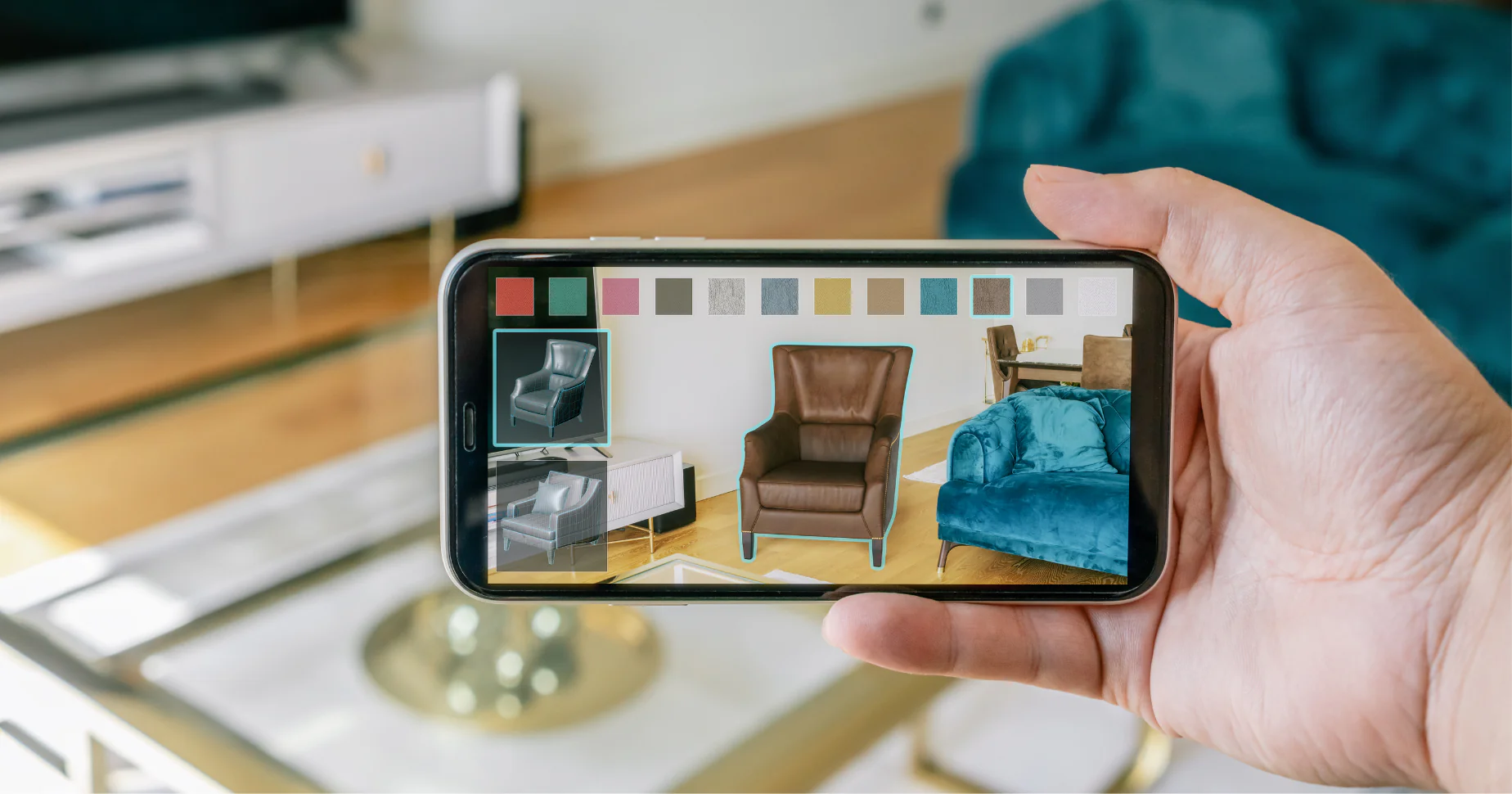Though still in its early stages, the AR market is expanding rapidly. Initially embraced by gamers and metaverse enthusiasts, AR is now attracting a broader audience. According to a McKinsey & Company survey, nearly half (48%) of respondents expressed interest in using AR and VR technologies for shopping within the next five years. This growing interest is mirrored in the marketing world, with 38% of marketers incorporating AR into their strategies in 2022, up significantly from 23% in 2017.
In this guide, we’ll explore what AR in ecommerce shopping entails, examine the current AR market, highlight key AR shopping trends for 2024, and introduce the best AR shopping apps available today.
What is AR in Ecommerce?
AR in ecommerce allows customers to virtually try on and test products using a smartphone, tablet, or AR headset. This technology can make users feel like they’re physically interacting with products in a store or see how items will look in their homes—or even on themselves, in the case of fashion.
For marketers, AR offers a powerful tool to engage customers by enabling pre-purchase experiences. Consumers can virtually try on clothing or makeup or visualize how furniture fits into their living spaces before making a purchase.
The AR Market Landscape
Tech giants like Meta and Google are accelerating this trend by investing heavily in AR. Google, for instance, recently acquired Raxium, a startup specializing in smart glasses, which could lead to major advancements in their AR offerings.
The evolution of smartphone cameras has also made AR shopping more accessible, with improved hardware and software enabling AR features across various apps. As a result, AR is becoming an increasingly attractive option for marketers looking to create engaging, consumer-friendly experiences.
Top 7 AR Shopping Trends in 2024
Social Media Apps and Camera Filters
The pandemic saw a surge in online activity, prompting brands to innovate to maintain consumer engagement. Social media apps like Snapchat and Instagram have been at the forefront of AR adoption, allowing brands to create AR filters that users can interact with. For example, Christian Dior’s 2021 campaign on Snapchat and Instagram garnered over 1.3 million impressions using AR filters.
To get started with AR on social media:
- Use SnapAR Lens Studio to create an AR lens for Snapchat.
- Use Meta Spark to build AR filters for Facebook or Instagram Stories.
- Ensure you have skilled team members who can create 3D models or artwork for AR campaigns.
Virtual Try-On
One of the most popular uses of AR is virtual try-on, particularly in the fashion and beauty industries. This technology allows customers to see how products like makeup, clothing, or accessories will look on them before buying. Brands like Sephora have already implemented AR filters for virtual try-ons on Instagram, enhancing the shopping experience and potentially reducing returns.
To implement virtual try-ons:
- Keep the AR experience simple to avoid technical issues.
- Integrate AR features into social commerce platforms like Instagram Shops.
- Use AR try-ons to give customers a more accurate sense of how products will look, reducing the likelihood of returns.
Virtual Showrooms
Virtual showrooms allow customers to place products, such as 3D furniture visualizations, within their real-world environments using AR. This technology can significantly boost conversion rates—merchants using 3D content in their stores have seen a 94% increase in conversions on average.
To create AR-enabled product listings:
- Use your product catalog to publish AR listings on your furniture e-commerce store.
- Ensure your AR objects effectively interact with the user’s environment by recognizing surfaces and planes.
- Provide clear instructions on how users can interact with AR objects.
Improved AR Hardware
Advances in mobile technology, such as better depth-sensing hardware (LiDAR and ToF), continue to enhance AR capabilities. The mobile AR market is expected to grow from $12.45 billion in 2021 to $36.26 billion in 2026. In addition to smartphones, companies like Google and Microsoft are developing AR-enabled smart glasses, which could further revolutionize the market.
To capitalize on improved AR hardware:
- Consider developing brand-specific AR apps using tools like Apple’s ARKit.
- Stay informed about advancements in AR hardware to ensure your brand’s AR offerings remain competitive.
AR Mirrors for In-Store Shopping
AR mirrors offer a novel way to enhance the in-store shopping experience. These mirrors can superimpose images onto a real mirror or use digital displays to allow customers to try on products virtually. While this technology is currently more popular in China, research shows there is growing interest in the U.S.
To explore AR mirrors for your store:
- Start with a trial in a flagship store to gauge customer interest and gather feedback.
- Consider the investment required for widespread implementation, including the cost of displays and software development.
Gamifying In-Store Shopping with AR
AR can also be used to make in-store shopping more entertaining. Brands like Tesco have successfully gamified the shopping experience by integrating AR into their apps. This approach can increase brand engagement, loyalty, and the time customers spend in-store.
To gamify your in-store experience:
- Tie AR experiences to specific products in-store to streamline implementation.
- Use QR codes to initiate the AR experience and guide users through it.
- Consider the appeal of gamification, especially for younger customers familiar with games like Pokémon Go.
Create Immersive Shopping Experiences with Zolak 3D Furniture Visualization
AR is a powerful tool that businesses are using today to create more engaging and immersive shopping experiences. As AR technology continues to evolve, it presents exciting opportunities for brands to connect with customers in innovative ways, making shopping more fun and confidence-inspiring.



